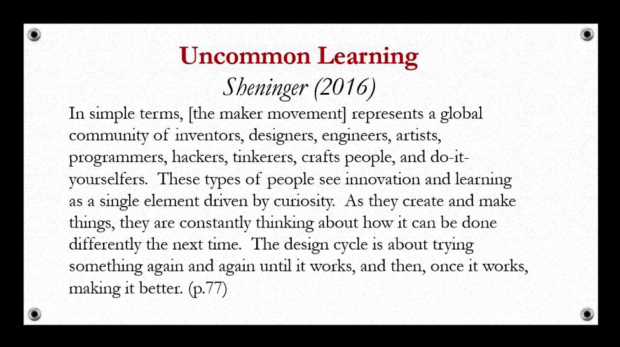

This week, MIT is host to the International Symposium on Academic Makerspaces (ISAM). The program, led by MIT Maker Czar Dr. Martin Culpepper, was organized by Higher Ed Makerspace Initiative (HEMI), which included Berkeley, CMU, Olin College, Yale, and other universities.
I gave the opening keynote, “Innovation at the Crossroads: Expanding the Role of Universities in the Maker Movement.” Over 300 people from around the world attended the sold-out conference, indicating strong interest in ways that the universities and colleges are embracing the maker movement. In my talk, I said that the maker movement needs universities as an institutional partner. More than any other institution, universities are about sharing knowledge, processes, and tools, just like the maker movement, but also a set of values such as openness, transparency, and collaboration.
“Higher education can spread what the maker movement has to offer and help increase its impact. No other institution is better able to do this. However, it’s a much bigger project than simply organizing makerspaces on campus, much bigger than providing students or even the community at large access to tools. Academic makerspaces should be hubs for local maker communities, connecting makerspaces throughout the community and offering training and mentoring for teachers, and others in the community. Think of how to locate the academic makerspace at the crossroads, so that it connects not only to education but also to business, to the community and to the broader culture.”
Dr. Aaron M. Hoover of Olin College of Engineering gave a talk titled, “Fostering Student Autonomy.” He cited how self-determination theory, developed by Edward L. Deci, supports the development models of students in makerspaces. Hoover pointed to an article by Deci that defined the theory’s application to the maker mindset:
“…promoting in students an interest in learning, a valuing of education, and a confidence in their own capacities and attributes. These outcomes are manifestations of being intrinsically motivated. ”
And also:
“…the inherent tendency to seek out novelty and challenges, to extend and exercise one’s capacities.”
The proceeding of the three-day conference can be found online as a PDF.
Every Child a Maker
Five Ways to Increase Student Engagement
Michelle Carlson of the Future Development Group writes on her site:
In reflecting with some amazing teachers on what we did last year, we realized that something really remarkable happened — we sent an entire grade level of kids on with such a different set of skills that even the substitutes have noticed, saying things like, “I’ve never seen a group of kids like this before.”
Michelle and the teachers articulated five strategies for working with kids, which are each discussed in length in her article.
- Ask the kids
- Make time for discussion
- Kick things off with videos
- Offer choice
- Allow students to work in groups
Every Child a Maker
Laura Fleming (@LFlemingEDU) shared a poster image on Twitter: “Hang this in your #makerspace. ‘EVERY’ seems more appropriate now than ever before.”
Pitsco Education Makerspace Catalog
Pitsco Education, located in Pittsburgh, Kansas, was started by three teachers in the 1970s. They have always focused on hands-on kits for education. Now Pitsco has announced a new makerspace catalog. “The makerspace catalog features 49 different maker projects tailored to elementary, middle-level, and high school students,” said a recent press release. “In addition to the maker projects, an assortment of tools, furniture, and storage options are available to round out any workspace.”
Uncommon Learning
Dr. Robin Kay (@kayuoit) posted this excellent summary of the maker movement for educators, quoting Eric Sheninger, a senior fellow with the International Center for Leadership in Education (ICLE). Prior to this he was the principal at New Milford High School. He is the author of Uncommon Learning: Creating Schools that Work for Kids.
Also don’t miss our annual 3D Printer Buyer’s Guide and this special strategy for how to use your new 3D printer in the classroom.
NPR Interview: “On The Lesson Plan: Make Stuff. Fail. Learn While You’re At It.”
Eric Westervelt, Education Correspondent for NPR, spoke to me about the maker movement, and called it “the philosophy that’s helping kids learn more creatively.” This particular section stood out for me:
Q. If you keep (making) free form and student-led, do you believe it can still be tied to curriculum and an educational plan?
A. Yes. I think a maker space is more like a library in that there are multiple subjects and multiple things that you can learn… What seems to be missing in school is how do these subjects integrate? How do they fit together in any meaningful way? Rather than saying, “This is science, over here is history,” I see schools taking this idea of projects and looking at: How do they support children in higher level learning?
I feel like this is a shift away from subject matter-based curriculum to more experiential curriculum or learning. It’s pretty early in these days, but I think it’s shifting around not what kids learn but how they learn.
A-Maize-ing Project: Corn Pixel Art
Looking for a uniquely nerdy holiday craft project? Pixel Corn Art will have you looking at an ear of corn as a pixel display. This project can be done to explore patterns for art, computation, or math.
One classic mathematical pattern you can make on a cylinder is a helix (basically a spiral around the surface of the cylinder) so in this first design we’ve marked off a double helix in each direction: two progressing one row to the right and one kernel down in each step, starting on opposite sides of the ear, and the other two progressing one row to the left and one kernel down.
Or you can just spell in kernels the name of your favorite magazine:
ADVERTISEMENT







